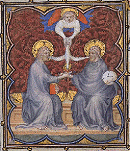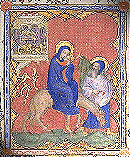
The Family Tree of Jesus of Nazareth
Never known from the gospels, but the product of the apocryphal books and
medieval imagination

Mary and Joseph
Before we look further into Mary’s history, as constructed by the “forbidden” apocrypha,
aided by some vivid imaginations, let us note the times when Mary actually is mentioned
in the Scriptures:
- The Annunciation - when the Angel Gabriel announces that she will be the Mother of
Jesus, and also informs her that her aging cousin, the long barren Elizabeth, is expecting
the child who will be His herald
- The Visitation - Mary travels to Judea to visit Elizabeth. John the Baptist, in his
mother’s womb, leaps for joy at Mary’s approach, and Elizabeth is given the grace to
know that Mary is the mother of the Saviour.
- The Nativity of Christ and the homage offered Him by the Wise Men from the
East
- Jesus’s Presentation at the Temple
- The Flight into Egypt - which the family undertakes to escape the murderous rage of
Herod the Great
- The Finding of Jesus in the Temple - Mary and Joseph look in vain for their lost
adolescent son for three days, then find Him displaying His wisdom before the elders in
the temple
- The Wedding Feast at Cana - Mary gently persuades her Son to work his first
miracle, when the supply of wine is exhausted, presumably because many unexpected
guests crashed the party in order to get a look at the newly acclaimed preacher - Jesus of
Nazareth. Jesus obliges by turning water into wine.
- There is one reference, during Jesus’s time of public ministry, where He is informed
that his mother is at the gate.
- Mary is present during Jesus’s crucifixion and referred to later in the Acts of the Apostles.
All in all, we know very little of Mary, and this would have been totally unacceptable to
medieval minds, which thrived on detail. The basis for most of the extended picture long
pre-dates the Middle Ages, since the apocryphal books, condemned by Church authorities
well before, date to the earliest Christian centuries. Their depiction in medieval art, and
their use in sermons delivered by many saints, caused them to have great popularity.
A complete overview would be beyond the scope of its page, but I should like to present
you with a sampler of the elaborate family tree with which our medieval friends were well
acquainted.
 Mary’s parents, whose names are not mentioned in the Scriptures, were known as Anne
(Hannah) and Joachim. These devout, generous and prosperous souls suffered the stigma
of having no children after many years of marriage. Amongst the Jews (which medieval
man occasionally remembered that Jesus and his family were), a lack of children meant
divine disfavour, and Joachim was barred from offering sacrifices at the temple as a
result.
Mary’s parents, whose names are not mentioned in the Scriptures, were known as Anne
(Hannah) and Joachim. These devout, generous and prosperous souls suffered the stigma
of having no children after many years of marriage. Amongst the Jews (which medieval
man occasionally remembered that Jesus and his family were), a lack of children meant
divine disfavour, and Joachim was barred from offering sacrifices at the temple as a
result.
Joachim, greatly discouraged, disappeared for a time, and the distraught Anne mourned
for him as if he had died. However, Joachim, prompted by an angel, was to learn that his
prayers for a child were to be answered.
Anne, who had dressed in her wedding robes to commemorate a great Jewish feast day,
was overjoyed to find that her husband had returned, and ran to greet him at the gate.
Sources are divided on what happened next, and several minds (contrary to Roman
Catholic teaching that Mary's beginnings were no different from ours) were to assert that a chaste kiss during this meeting led to Mary’s
conception.
 Anne and Joachim dedicated their child to God, and, at age 3, she became the first girl (not to mention the oldest child) in recorded history to have a Presentation ceremony.
The young Mary remained at the temple school (an institution that existed only in this
context!), balancing her life between contemplation and learning such domestic arts as
dyeing and weaving. The latter were to serve her well in later years, when the poverty of
the family demanded her contribution.
Anne and Joachim dedicated their child to God, and, at age 3, she became the first girl (not to mention the oldest child) in recorded history to have a Presentation ceremony.
The young Mary remained at the temple school (an institution that existed only in this
context!), balancing her life between contemplation and learning such domestic arts as
dyeing and weaving. The latter were to serve her well in later years, when the poverty of
the family demanded her contribution.
This Jewish maiden’s history was unique in far more ways than merely the obvious one.
Though vows of chastity were not taken by Jewish women, except among the sect of the
Essenes, Mary was to do so very young. This presented a problem when she reached
puberty. A nubile maiden would defile the holy temple during her menstrual cycles,
according to the laws of Leviticus and Deuteronomy, and even this extraordinary young
lady was not exempted from this prohibition.
It was decided that Mary would be given to a husband who would hold her “in trust”, and
who therefore needed to be both virtuous and of advanced years. During a contest for her
hand, the elderly widower Joseph was to have a lily sprout from the staff he held, and the
prize was his. Their betrothal presumably followed at once.
 Shortly afterward, Mary was visited by the angel Gabriel, who announced that she was to
be the Mother of the long-awaited Messiah, the Son of God. She then became pregnant by
the power of the Holy Spirit (which medieval artists depicted as involving a perfectly
formed, tiny child descending on a sunbeam into his mother’s right ear.) Directly
afterward, Mary went to visit her cousin Elizabeth, and remained there three months, until
John the Baptist was born and had his circumcision ceremony.
Shortly afterward, Mary was visited by the angel Gabriel, who announced that she was to
be the Mother of the long-awaited Messiah, the Son of God. She then became pregnant by
the power of the Holy Spirit (which medieval artists depicted as involving a perfectly
formed, tiny child descending on a sunbeam into his mother’s right ear.) Directly
afterward, Mary went to visit her cousin Elizabeth, and remained there three months, until
John the Baptist was born and had his circumcision ceremony.
Needless to say, Joseph was quite troubled when his betrothed returned from her journey
with a bun in the oven. (Many Christian authors speculated that Joseph believed her the
victim of abduction, not one guilty of adultery.) He considered divorcing her quietly, to
avoid her being stoned to death for adultery as the law prescribed, but he was informed, in
a dream, of the pregnancy’s special character, and he and Mary were wed.
For further details of Jesus’s childhood, please see The child
Jesus
Jesus’s maternal grandmother and aunts
 In her youth, Anne, who was raised in the vicinity of Mount Carmel, had contemplated a
life of perpetual virginity. (This was a highly individualistic family.) However, the monks
of the areas had a premonition, solidified by angelic revelations, that the Saviour was to be
her descendant, and she was married to the pious and wealthy Joachim.
In her youth, Anne, who was raised in the vicinity of Mount Carmel, had contemplated a
life of perpetual virginity. (This was a highly individualistic family.) However, the monks
of the areas had a premonition, solidified by angelic revelations, that the Saviour was to be
her descendant, and she was married to the pious and wealthy Joachim.
Anne was widowed shortly after the infant Mary’s presentation in the temple. She would
marry twice again, to Cleopas and to Salomas, and, with unprecedented fertility, bear two
more daughters, both named Mary in remembrance of her firstborn. Jesus’s aunts were
known as Mary Salome and Mary Cleopas, and were to be perpetually confused with the Maries who
are mentioned in the scriptures as having been present for the crucifixion.
Mary Cleopas bore four sons, James the Just, Joses, Simon and Jude, who are named in
the Scriptures as “Jesus’s brothers” because of the close kinship. Mary Salome married
Zebedee, and their sons, James and John, were among the Apostles, rounding out a quite
distinguished family circle.
Elizabeth had married Joachim’s nephew, Zacharias (son of Jacob). Since Zacharias also
was Joseph’s brother, the family ties are more extensive than the scriptures illustrate.
Joseph’s other brother, Clopas, was the father of Simeon, the second bishop of
Jerusalem.
Jesus’s great-grandmother
 Anne’s mother, Esmerentia, has perhaps the most intriguing history of all the family
members. Esmerentia was born, of David’s line, at the foot of Mount Carmel. She
embraced a monastic life (this family were trend-setters, and “way ahead of their time”) in
the company of the Carmelite monks who dwelled in the vicinity.
Anne’s mother, Esmerentia, has perhaps the most intriguing history of all the family
members. Esmerentia was born, of David’s line, at the foot of Mount Carmel. She
embraced a monastic life (this family were trend-setters, and “way ahead of their time”) in
the company of the Carmelite monks who dwelled in the vicinity.
The monks had various revelations about Esmerentia, and were granted a vision of the
Saviour of the World’s being her descendant. Though Esmerentia had been dedicated to
virginity, she was not bound by perpetual vows, and her unique role, as the monks had
discerned, needed to be fulfilled at once.
Unfortunately, Esmerentia’s marital history was to be quite tumultuous. The entire reason
for her marriage, of course, was that the line be continued to make way for the Messiah.
Her first six husbands, whose mindset was not sufficiently elevated to the mystic character
of the task at hand, unfortunately permitted themselves lustful thoughts when they entered
the bridal chamber, and were quickly dispatched to sheol by the angel of death.
Seven was the lucky number here, and the noble husband Stollanus apparently was able to
attend to business without the intrusion of lust. The children of this marriage included
Anne and Esmeria.
Esmeria’s grandson, Servius, is of note, and will conclude this treatment of family lore.
Servius, who had inherited a tendency to great piety, travelled to Rome as a young man,
and so impressed the Pope Saint Peter that the latter presented Servius with a duplicate set
of the Keys of the Kingdom. (These were composed of silver rather than gold, since
Servius was to be bishop of Tongres, not Pope.) Apparently, Servius’s life span was to be
one surpassed only by Methusaleh, since he was to survive to convert Attila four centuries
later. For reasons unknown, Servius later was martyred by the peasants, then buried in
Maastricht cathedral.
This delightful chronicle of Jesus’s family complements our understanding of the
awareness that medieval man had of divine providence, and their identification with holy
characters on a very human plane.

For more about the family and Jesus's early life, read the delightful apocrypha:

© 1996 by Elizabeth G. Melillo - but, since each Web site needs one reference of this type, my thanks to my dearest friend, Richard, for the idea of including this topic
gloriana@oocities.com
 "All that is not eternal is eternally out of date." - C.S. Lewis
"All that is not eternal is eternally out of date." - C.S. Lewis
This page hosted by  Get your own Free Home Page
Get your own Free Home Page